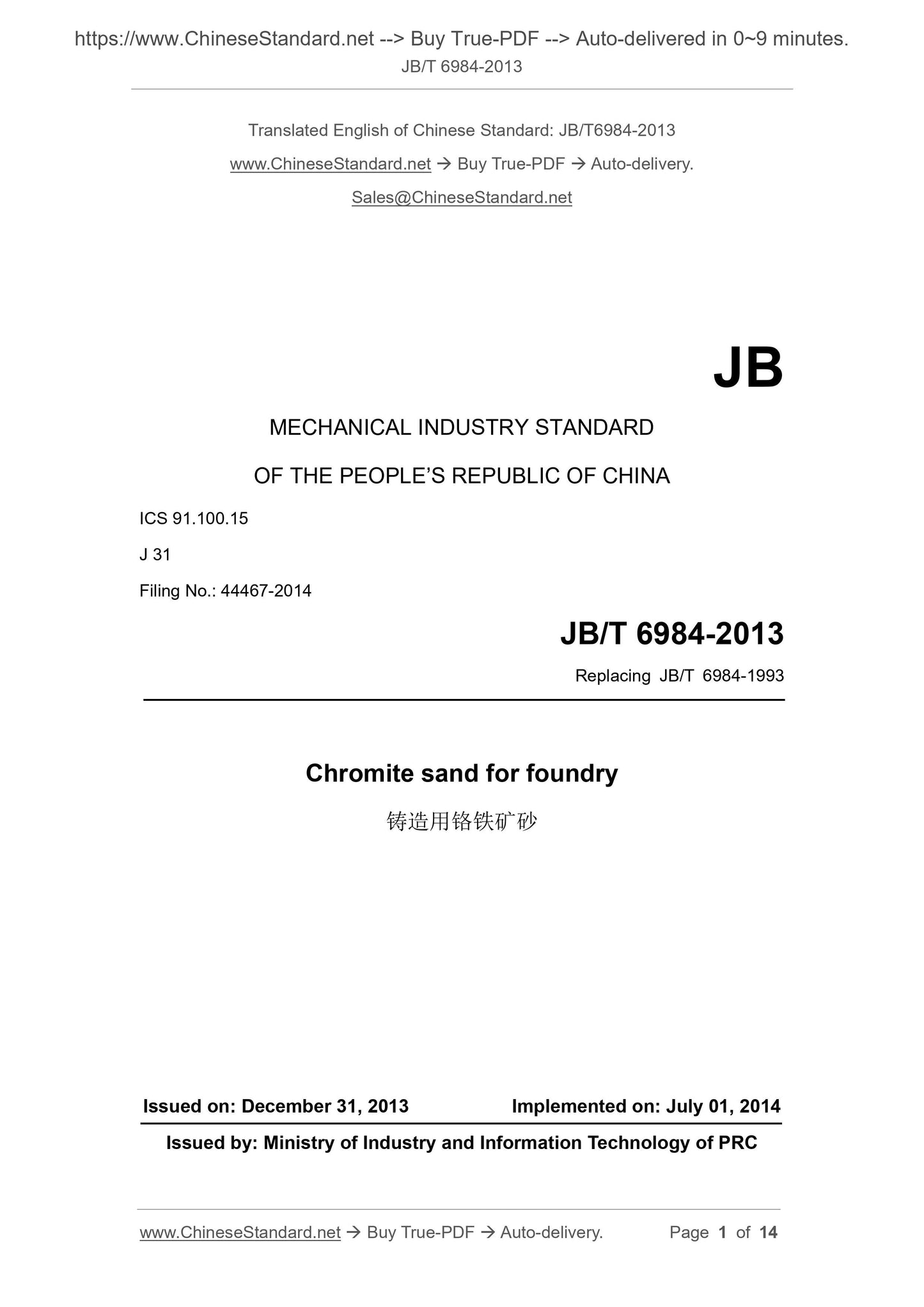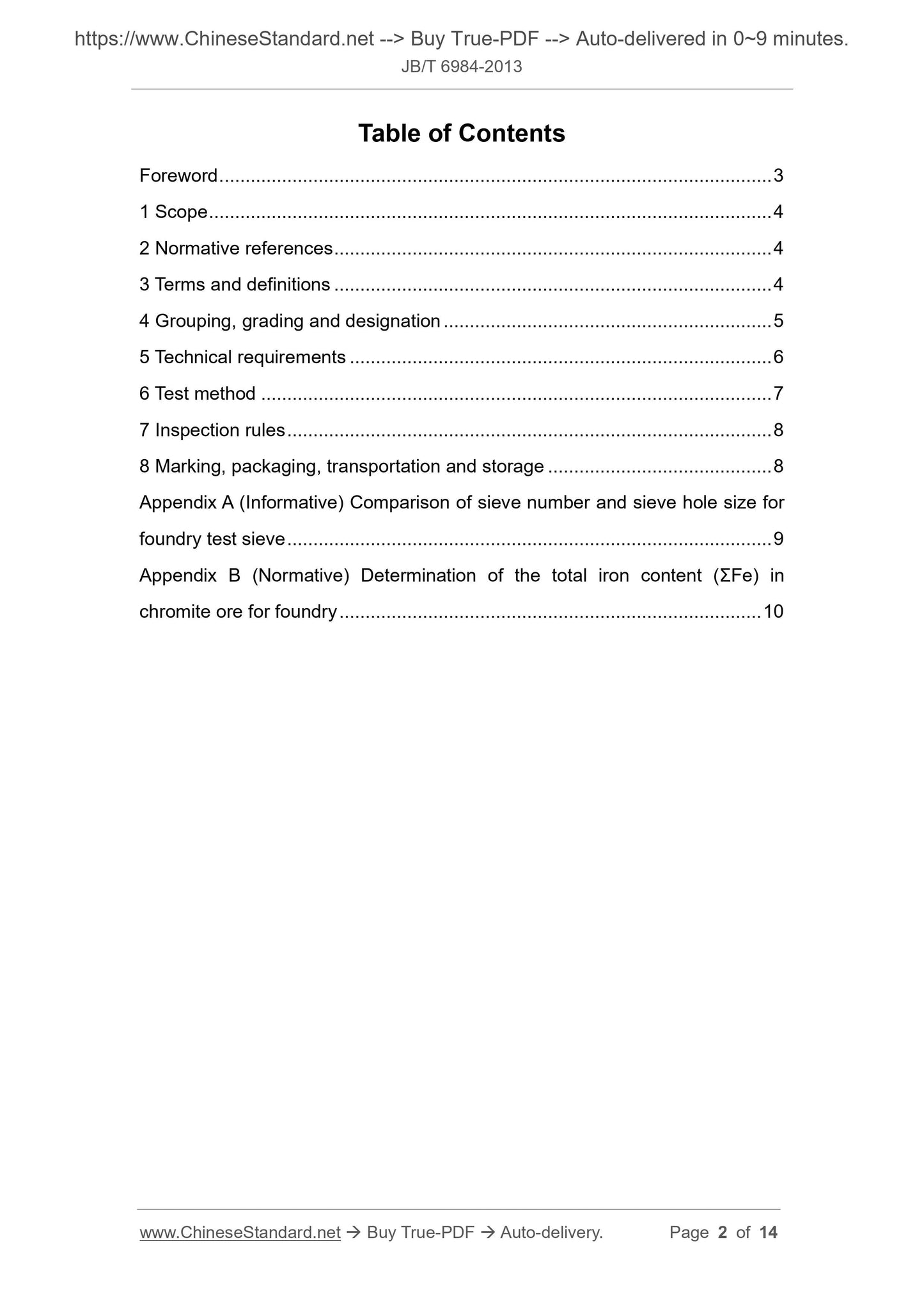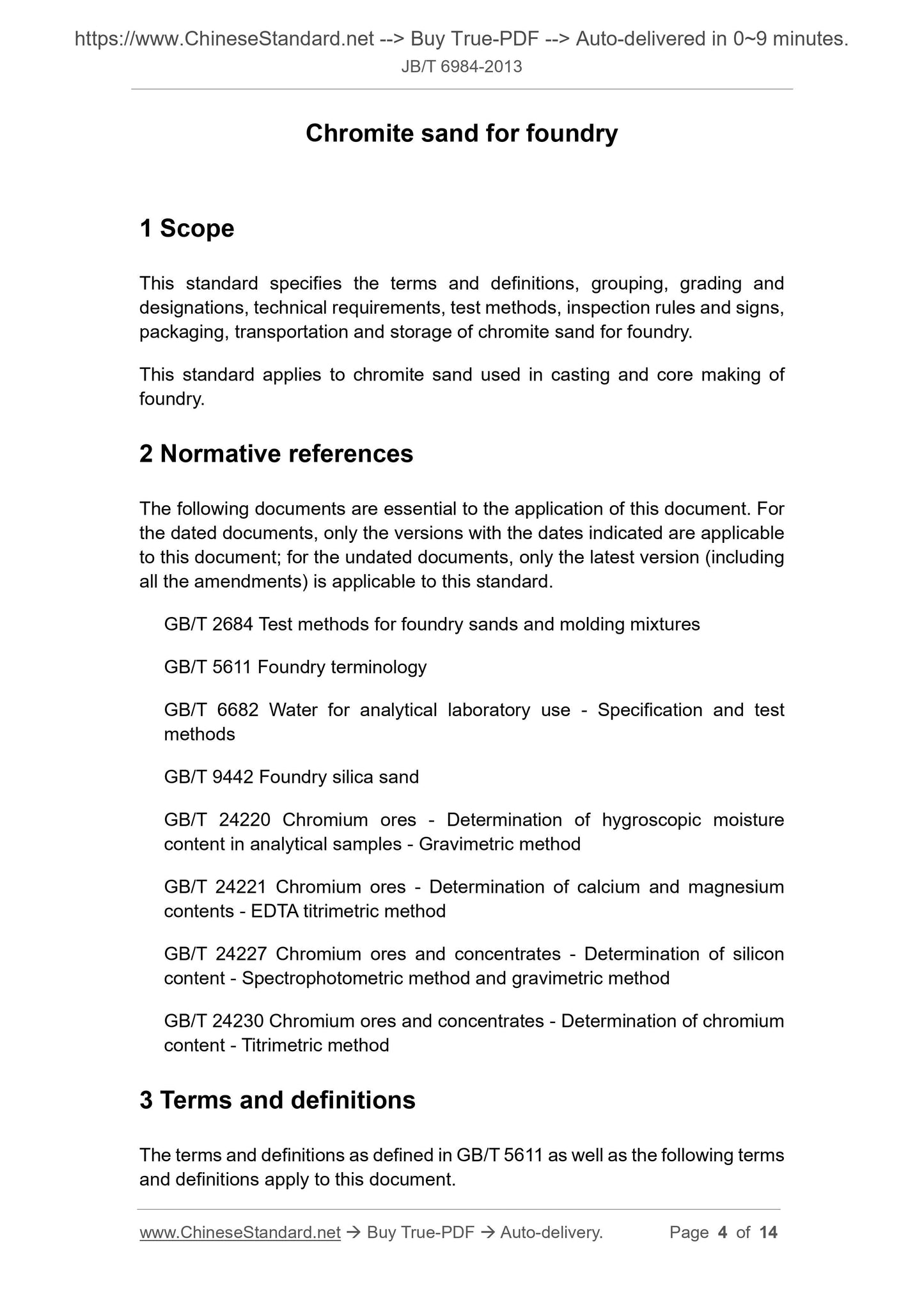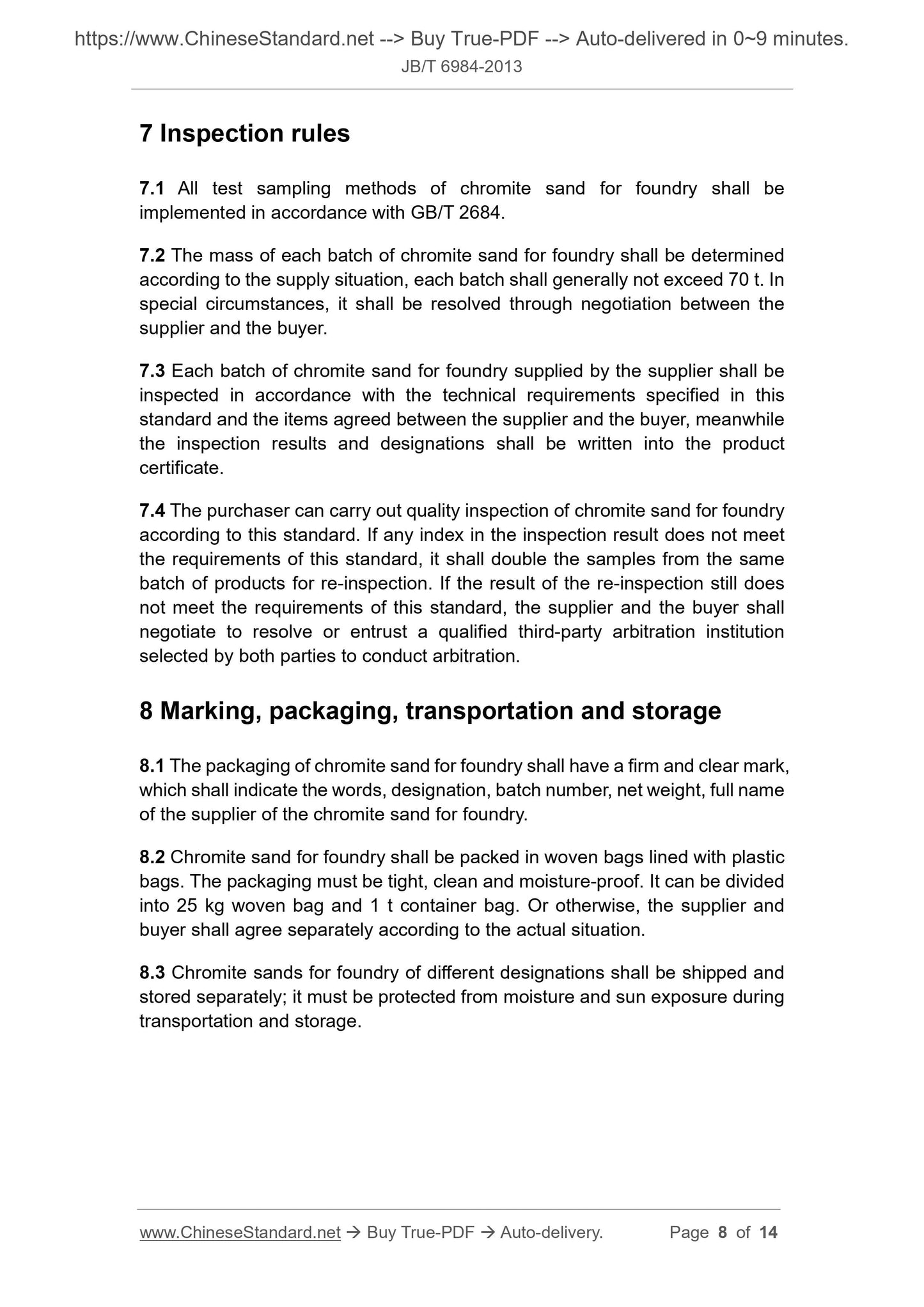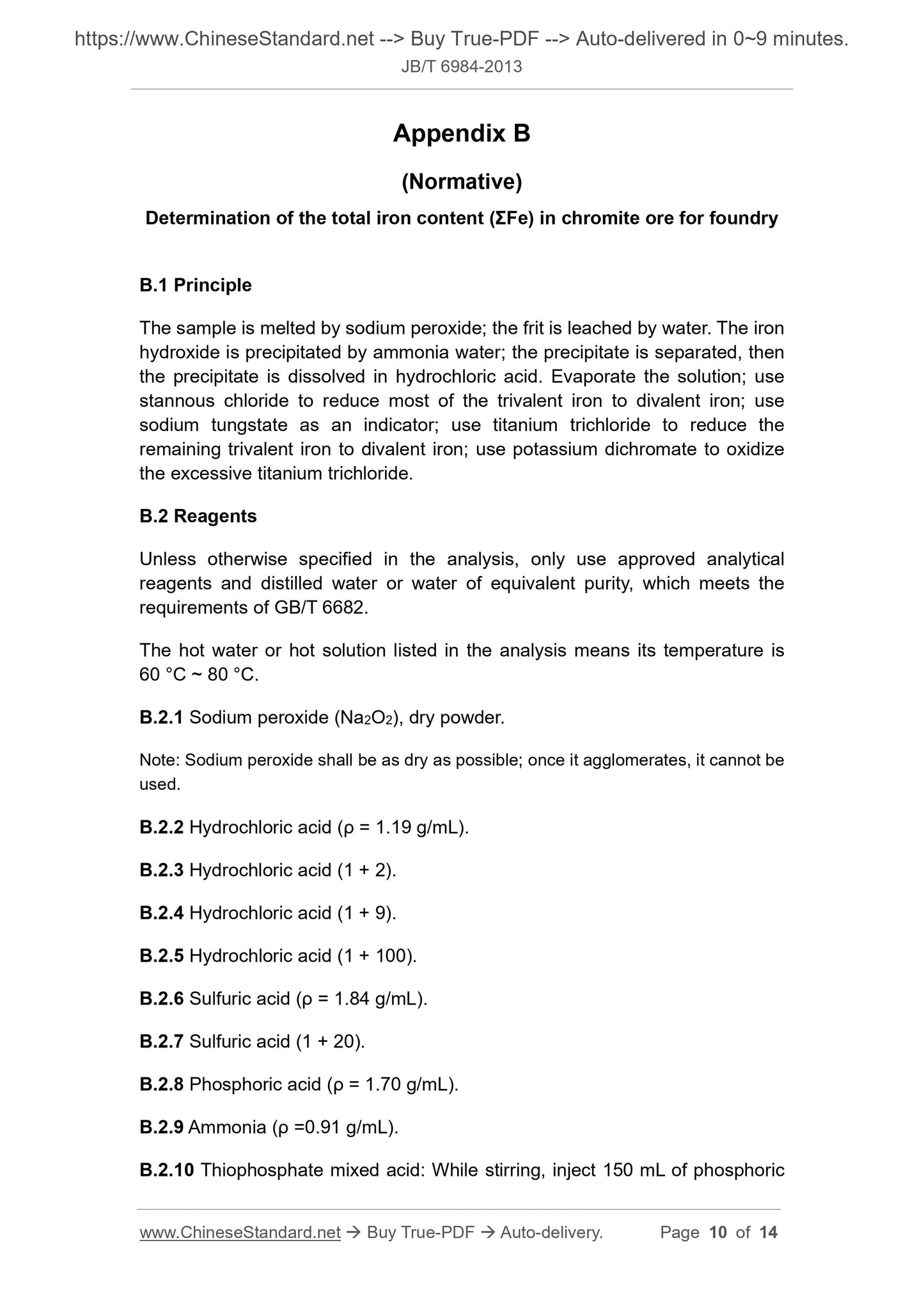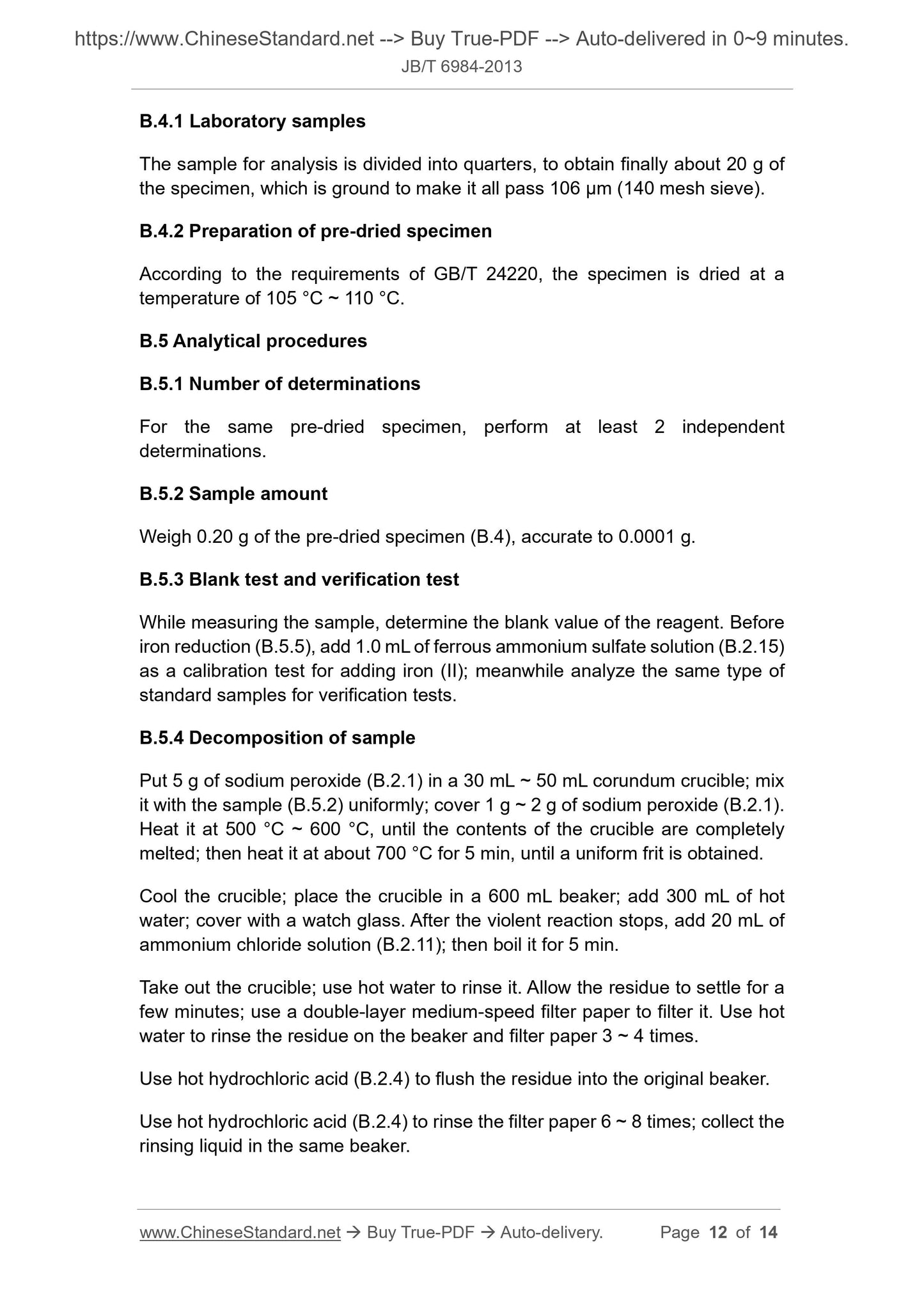1
/
de
6
PayPal, credit cards. Download editable-PDF & invoice in 1 second!
JB/T 6984-2013 English PDF (JBT6984-2013)
JB/T 6984-2013 English PDF (JBT6984-2013)
Prix habituel
$245.00 USD
Prix habituel
Prix promotionnel
$245.00 USD
Prix unitaire
/
par
Frais d'expédition calculés à l'étape de paiement.
Impossible de charger la disponibilité du service de retrait
Delivery: 3 seconds. Download true-PDF + Invoice.
Get QUOTATION in 1-minute: Click JB/T 6984-2013
Historical versions: JB/T 6984-2013
Preview True-PDF (Reload/Scroll if blank)
JB/T 6984-2013: Chromite sand for foundry
JB/T 6984-2013
JB
MECHANICAL INDUSTRY STANDARD
OF THE PEOPLE’S REPUBLIC OF CHINA
ICS 91.100.15
J 31
Filing No.: 44467-2014
Replacing JB/T 6984-1993
Chromite sand for foundry
ISSUED ON: DECEMBER 31, 2013
IMPLEMENTED ON: JULY 01, 2014
Issued by: Ministry of Industry and Information Technology of PRC
Table of Contents
Foreword ... 3
1 Scope ... 4
2 Normative references ... 4
3 Terms and definitions ... 4
4 Grouping, grading and designation ... 5
5 Technical requirements ... 6
6 Test method ... 7
7 Inspection rules ... 8
8 Marking, packaging, transportation and storage ... 8
Appendix A (Informative) Comparison of sieve number and sieve hole size for
foundry test sieve ... 9
Appendix B (Normative) Determination of the total iron content (ΣFe) in
chromite ore for foundry ... 10
Chromite sand for foundry
1 Scope
This standard specifies the terms and definitions, grouping, grading and
designations, technical requirements, test methods, inspection rules and signs,
packaging, transportation and storage of chromite sand for foundry.
This standard applies to chromite sand used in casting and core making of
foundry.
2 Normative references
The following documents are essential to the application of this document. For
the dated documents, only the versions with the dates indicated are applicable
to this document; for the undated documents, only the latest version (including
all the amendments) is applicable to this standard.
GB/T 2684 Test methods for foundry sands and molding mixtures
GB/T 5611 Foundry terminology
GB/T 6682 Water for analytical laboratory use - Specification and test
methods
GB/T 9442 Foundry silica sand
GB/T 24220 Chromium ores - Determination of hygroscopic moisture
content in analytical samples - Gravimetric method
GB/T 24221 Chromium ores - Determination of calcium and magnesium
contents - EDTA titrimetric method
GB/T 24227 Chromium ores and concentrates - Determination of silicon
content - Spectrophotometric method and gravimetric method
GB/T 24230 Chromium ores and concentrates - Determination of chromium
content - Titrimetric method
3 Terms and definitions
The terms and definitions as defined in GB/T 5611 as well as the following terms
and definitions apply to this document.
7 Inspection rules
7.1 All test sampling methods of chromite sand for foundry shall be
implemented in accordance with GB/T 2684.
7.2 The mass of each batch of chromite sand for foundry shall be determined
according to the supply situation, each batch shall generally not exceed 70 t. In
special circumstances, it shall be resolved through negotiation between the
supplier and the buyer.
7.3 Each batch of chromite sand for foundry supplied by the supplier shall be
inspected in accordance with the technical requirements specified in this
standard and the items agreed between the supplier and the buyer, meanwhile
the inspection results and designations shall be written into the product
certificate.
7.4 The purchaser can carry out quality inspection of chromite sand for foundry
according to this standard. If any index in the inspection result does not meet
the requirements of this standard, it shall double the samples from the same
batch of products for re-inspection. If the result of the re-inspection still does
not meet the requirements of this standard, the supplier and the buyer shall
negotiate to resolve or entrust a qualified third-party arbitration institution
selected by both parties to conduct arbitration.
8 Marking, packaging, transportation and storage
8.1 The packaging of chromite sand for foundry shall have a firm and clear mark,
which shall indicate the words, designation, batch number, net weight, full name
of the supplier of the chromite sand for foundry.
8.2 Chromite sand for foundry shall be packed in woven bags lined with plastic
bags. The packaging must be tight, clean and moisture-proof. It can be divided
into 25 kg woven bag and 1 t container bag. Or otherwise, the supplier and
buyer shall agree separately according to the actual situation.
8.3 Chromite sands for foundry of different designations shall be shipped and
stored separately; it must be protected from moisture and sun exposure during
transportation and storage.
Appendix B
(Normative)
Determination of the total iron content (ΣFe) in chromite ore for foundry
B.1 Principle
The sample is melted by sodium peroxide; the frit is leached by water. The iron
hydroxide is precipitated by ammonia water; the precipitate is separated, then
the precipitate is dissolved in hydrochloric acid. Evaporate the solution; use
stannous chloride to reduce most of the trivalent iron to divalent iron; use
sodium tungstate as an indicator; use titanium trichloride to reduce the
remaining trivalent iron to divalent iron; use potassium dichromate to oxidize
the excessive titanium trichloride.
B.2 Reagents
Unless otherwise specified in the analysis, only use approved analytical
reagents and distilled water or water of equivalent purity, which meets the
requirements of GB/T 6682.
The hot water or hot solution listed in the analysis means its temperature is
60 °C ~ 80 °C.
B.2.1 Sodium peroxide (Na2O2), dry powder.
Note: Sodium peroxide shall be as dry as possible; once it agglomerates, it cannot be
used.
B.2.2 Hydrochloric acid (ρ = 1.19 g/mL).
B.2.3 Hydrochloric acid (1 + 2).
B.2.4 Hydrochloric acid (1 + 9).
B.2.5 Hydrochloric acid (1 + 100).
B.2.6 Sulfuric acid (ρ = 1.84 g/mL).
B.2.7 Sulfuric acid (1 + 20).
B.2.8 Phosphoric acid (ρ = 1.70 g/mL).
B.2.9 Ammonia (ρ =0.91 g/mL).
B.2.10 Thiophosphate mixed acid: While stirring, inject 150 mL of phosphoric
B.4.1 Laboratory samples
The sample for analysis is divided into quarters, to obtain finally about 20 g of
the specimen, which is ground to make it all pass 106 µm (140 mesh sieve).
B.4.2 Preparation of pre-dried specimen
According to the requirements of GB/T 24220, the specimen is dried at a
temperature of 105 °C ~ 110 °C.
B.5 Analytical procedures
B.5.1 Number of determinations
For the same pre-dried specimen, perform at least 2 independent
determinations.
B.5.2 Sample amount
Weigh 0.20 g of the pre-dried specimen (B.4), accurate to 0.0001 g.
B.5.3 Blank test and verification test
While measuring the sample, determine the blank value of the reagent. Before
iron reduction (B.5.5), add 1.0 mL of ferrous ammonium sulfate solution (B.2.15)
as a calibration test for adding iron (II); meanwhile analyze the same type of
standard samples for verification tests.
B.5.4 Decomposition of sample
Put 5 g of sodium peroxide (B.2.1) in a 30 mL ~ 50 mL corundum crucible; mix
it with the sample (B.5.2) uniformly; cover 1 g ~ 2 g of sodium peroxide (B.2.1).
Heat it at 500 °C ~ 600 °C, until the contents of the crucible are completely
melted; then heat it at about 700 °C for 5 min, until a uniform frit is obtained.
Cool the crucible; place the crucible in a 600 mL beaker; add 300 mL of hot
water; cover with a watch glass. After the violent reaction stops, add 20 mL of
ammonium chloride solution (B.2.11); then boil it for 5 min.
Take out the crucible; use hot water to rinse it. Allow the residue to settle for a
few minutes; use a double-layer medium-speed filter paper to filter it. Use hot
water to rinse the residue on the beaker and filter paper 3 ~ 4 times.
Use hot hydrochloric acid (B.2.4) to flush the...
Get QUOTATION in 1-minute: Click JB/T 6984-2013
Historical versions: JB/T 6984-2013
Preview True-PDF (Reload/Scroll if blank)
JB/T 6984-2013: Chromite sand for foundry
JB/T 6984-2013
JB
MECHANICAL INDUSTRY STANDARD
OF THE PEOPLE’S REPUBLIC OF CHINA
ICS 91.100.15
J 31
Filing No.: 44467-2014
Replacing JB/T 6984-1993
Chromite sand for foundry
ISSUED ON: DECEMBER 31, 2013
IMPLEMENTED ON: JULY 01, 2014
Issued by: Ministry of Industry and Information Technology of PRC
Table of Contents
Foreword ... 3
1 Scope ... 4
2 Normative references ... 4
3 Terms and definitions ... 4
4 Grouping, grading and designation ... 5
5 Technical requirements ... 6
6 Test method ... 7
7 Inspection rules ... 8
8 Marking, packaging, transportation and storage ... 8
Appendix A (Informative) Comparison of sieve number and sieve hole size for
foundry test sieve ... 9
Appendix B (Normative) Determination of the total iron content (ΣFe) in
chromite ore for foundry ... 10
Chromite sand for foundry
1 Scope
This standard specifies the terms and definitions, grouping, grading and
designations, technical requirements, test methods, inspection rules and signs,
packaging, transportation and storage of chromite sand for foundry.
This standard applies to chromite sand used in casting and core making of
foundry.
2 Normative references
The following documents are essential to the application of this document. For
the dated documents, only the versions with the dates indicated are applicable
to this document; for the undated documents, only the latest version (including
all the amendments) is applicable to this standard.
GB/T 2684 Test methods for foundry sands and molding mixtures
GB/T 5611 Foundry terminology
GB/T 6682 Water for analytical laboratory use - Specification and test
methods
GB/T 9442 Foundry silica sand
GB/T 24220 Chromium ores - Determination of hygroscopic moisture
content in analytical samples - Gravimetric method
GB/T 24221 Chromium ores - Determination of calcium and magnesium
contents - EDTA titrimetric method
GB/T 24227 Chromium ores and concentrates - Determination of silicon
content - Spectrophotometric method and gravimetric method
GB/T 24230 Chromium ores and concentrates - Determination of chromium
content - Titrimetric method
3 Terms and definitions
The terms and definitions as defined in GB/T 5611 as well as the following terms
and definitions apply to this document.
7 Inspection rules
7.1 All test sampling methods of chromite sand for foundry shall be
implemented in accordance with GB/T 2684.
7.2 The mass of each batch of chromite sand for foundry shall be determined
according to the supply situation, each batch shall generally not exceed 70 t. In
special circumstances, it shall be resolved through negotiation between the
supplier and the buyer.
7.3 Each batch of chromite sand for foundry supplied by the supplier shall be
inspected in accordance with the technical requirements specified in this
standard and the items agreed between the supplier and the buyer, meanwhile
the inspection results and designations shall be written into the product
certificate.
7.4 The purchaser can carry out quality inspection of chromite sand for foundry
according to this standard. If any index in the inspection result does not meet
the requirements of this standard, it shall double the samples from the same
batch of products for re-inspection. If the result of the re-inspection still does
not meet the requirements of this standard, the supplier and the buyer shall
negotiate to resolve or entrust a qualified third-party arbitration institution
selected by both parties to conduct arbitration.
8 Marking, packaging, transportation and storage
8.1 The packaging of chromite sand for foundry shall have a firm and clear mark,
which shall indicate the words, designation, batch number, net weight, full name
of the supplier of the chromite sand for foundry.
8.2 Chromite sand for foundry shall be packed in woven bags lined with plastic
bags. The packaging must be tight, clean and moisture-proof. It can be divided
into 25 kg woven bag and 1 t container bag. Or otherwise, the supplier and
buyer shall agree separately according to the actual situation.
8.3 Chromite sands for foundry of different designations shall be shipped and
stored separately; it must be protected from moisture and sun exposure during
transportation and storage.
Appendix B
(Normative)
Determination of the total iron content (ΣFe) in chromite ore for foundry
B.1 Principle
The sample is melted by sodium peroxide; the frit is leached by water. The iron
hydroxide is precipitated by ammonia water; the precipitate is separated, then
the precipitate is dissolved in hydrochloric acid. Evaporate the solution; use
stannous chloride to reduce most of the trivalent iron to divalent iron; use
sodium tungstate as an indicator; use titanium trichloride to reduce the
remaining trivalent iron to divalent iron; use potassium dichromate to oxidize
the excessive titanium trichloride.
B.2 Reagents
Unless otherwise specified in the analysis, only use approved analytical
reagents and distilled water or water of equivalent purity, which meets the
requirements of GB/T 6682.
The hot water or hot solution listed in the analysis means its temperature is
60 °C ~ 80 °C.
B.2.1 Sodium peroxide (Na2O2), dry powder.
Note: Sodium peroxide shall be as dry as possible; once it agglomerates, it cannot be
used.
B.2.2 Hydrochloric acid (ρ = 1.19 g/mL).
B.2.3 Hydrochloric acid (1 + 2).
B.2.4 Hydrochloric acid (1 + 9).
B.2.5 Hydrochloric acid (1 + 100).
B.2.6 Sulfuric acid (ρ = 1.84 g/mL).
B.2.7 Sulfuric acid (1 + 20).
B.2.8 Phosphoric acid (ρ = 1.70 g/mL).
B.2.9 Ammonia (ρ =0.91 g/mL).
B.2.10 Thiophosphate mixed acid: While stirring, inject 150 mL of phosphoric
B.4.1 Laboratory samples
The sample for analysis is divided into quarters, to obtain finally about 20 g of
the specimen, which is ground to make it all pass 106 µm (140 mesh sieve).
B.4.2 Preparation of pre-dried specimen
According to the requirements of GB/T 24220, the specimen is dried at a
temperature of 105 °C ~ 110 °C.
B.5 Analytical procedures
B.5.1 Number of determinations
For the same pre-dried specimen, perform at least 2 independent
determinations.
B.5.2 Sample amount
Weigh 0.20 g of the pre-dried specimen (B.4), accurate to 0.0001 g.
B.5.3 Blank test and verification test
While measuring the sample, determine the blank value of the reagent. Before
iron reduction (B.5.5), add 1.0 mL of ferrous ammonium sulfate solution (B.2.15)
as a calibration test for adding iron (II); meanwhile analyze the same type of
standard samples for verification tests.
B.5.4 Decomposition of sample
Put 5 g of sodium peroxide (B.2.1) in a 30 mL ~ 50 mL corundum crucible; mix
it with the sample (B.5.2) uniformly; cover 1 g ~ 2 g of sodium peroxide (B.2.1).
Heat it at 500 °C ~ 600 °C, until the contents of the crucible are completely
melted; then heat it at about 700 °C for 5 min, until a uniform frit is obtained.
Cool the crucible; place the crucible in a 600 mL beaker; add 300 mL of hot
water; cover with a watch glass. After the violent reaction stops, add 20 mL of
ammonium chloride solution (B.2.11); then boil it for 5 min.
Take out the crucible; use hot water to rinse it. Allow the residue to settle for a
few minutes; use a double-layer medium-speed filter paper to filter it. Use hot
water to rinse the residue on the beaker and filter paper 3 ~ 4 times.
Use hot hydrochloric acid (B.2.4) to flush the...
Share
